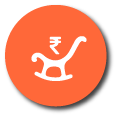What is Life Insurance?
The purpose of life insurance is to offer your family members with a degree of financial stability when you die. Therefore, when you buy a life insurance policy, you must take into consideration.

- Your financial condition and the quality of life that you want to sustain for your family members or survivors. For instance, who would be accountable for the funeral expenses and final hospital fees?
- Would your family be forced to move?
- Will there be sufficient resources for prospective or ongoing expenditures such as day-care, household bills and school?
It is sensible to reassess your life insurance policies yearly or when you encounter a notable life incident such as a wedding, annulment, birth or adoption of a kid or acquiring a significant asset such as a home or business.
Life Insurance Policy Types -
- Term Insurance
- Endowment Policy
- ULIP - Unit Linked Insurance Plan
- Money-Back Life Insurance
- Whole Life Insurance

Term plan – Pure Life Insurance
Term insurance is pure insurance because there are no savings included. Term life insurance provides coverage to the claimant for the agreed sum insured until the agreed term. In the event of the insured's death during the agreed policy duration, the insurance provider shall reimburse the insured's amount to the insured's claimant/beneficiary/lawful successor. If the insured exceeds the age or passes the term duration, the policy shall be discontinued and the premium charged shall not be refunded to the insured. Because there is no requirement to repay any amount at the point of maturity, the premiums for term life insurance are quite minimal. Policies are now applicable for 15, 20, and 25 years. It can also be bought until one reaches 65, 70, 75, 80, 85 years of age. Also, few corporations have come up with a lifetime policy, where insurance cover is provided until the age of 99 / 100 years.

Traditional Plan – Insurance cum Investment Policy
In this, the insurance pay-out granted is split into two portions one for insurance and the other for investment. Insured/recipients receive lump-sum gains in the traditional plan to the level of the insured amount + return on savings made from the premium paid either on the demise or on policy expiration. This return is given in the mode of a cashback or a reward. If a traditional long-term policy is purchased, it acts as a useful tool for creating corpus that can be used for significant capital expenditures such as child graduation / post-graduation, wedding, and retirement savings. The purchase of traditional plans develops the routine of obligatory savings which in the existing spending economy situation is very useful. There are several kinds of traditional policies:

Unit Linked Insurance Plan – ULIP
It is an investment-oriented scheme, in which the premium charged is partially used as a lifelong liability shield and the rest is invested in financial markets, shares, debt securities, balance funds, hybrid funds, etc. to achieve full benefit for the policy owner. The policyholder can choose the form of investment and the company in which the amount is to be invested. ULIP is known to be one of the excellent choices in the present situation where life insurance + investment in one go is given and the flexibility to choose the type of investment as per appetite for risk of the insurer. Insured individuals can also withdraw the money if and when necessary, but usually 5 years after fulfillment of the lock-in date.

ENDOWMENT PLAN
Endowment plan is a long-term saving cum insurance program. Generally speaking, the main target of the plan is to accrue corpus for the family in the event of demise or retirement in the event of maturity. Usually, the money paid at the time of the policyholder’s maturity or demise is much greater owing to the long period of the investment and the constant accumulation of capital per year. These days, there is also an endowment policy with shortened premium payment terms but prolonged life span or maturity terms.

MONEY-BACK PLAN
As the title suggests, this policy is being drawn with the intent of obtaining cashback on a routine basis after a certain amount of time. The money handed back may decrease the quantity insured or may be used as revenue from the quantity invested keeping the percentage insured untouched. Here the amount is paid for the chosen tenure and the money is given back after the end of some years. There may be a range of choices in the Money-back plan:
- The premium fee is halted after payment for agreed tenure and money begins to be returned to the insured person for the determined period –insurance coverage may or may not be accessible once payment of the premium has been blocked.
- Premium money is not halted and funds begin to be returned to the insured person for an agreed period –insurance cover stays until the date of maturity. Loyalty or assured bonuses may occur at the time of maturity/death of the insured person.
- Insurance protection raises each year until the payments are made and declines when the money returns. In this, as well, there may be a loyalty reward or an assured bonus at the end of the maturity period.
There are several money-back schemes with all insurers with many choices on how funds are to be returned and how long insurance cover you would like.

Child Plan
Child insurance provides financial stability for your children's learning and wedding expenditures. In this case, the premium paid by the parents guarantees the life of the kid and the lump-sum amount is paid to the kids at agreed periods, but after the age of 18. Even after all the amount has been reimbursed, the kid's life stays intact. This is the smartest technique to plan children's college or post-graduation expenditures. There is a slight chance that, in the event of the demise of the issuer, the premium should be paid to the kid which is not feasible due to the child's age. So the companies have emerged with the exemption from the premium add-on.

Retirement Plan
The retirement plan is known as a Pension or an Annuity plan. Premium accrued during the tenure shall be collected and paid in either lump sum or recurring instalments to the insured at his age of retirement, usually 60 years. In the event of the demise of the insured during the policy period, the predetermined sum shall be paid to the claimant. One might also spend a one-time lump-sum fee and receive annuity on a monthly or an annual basis his/her entire life. In that case, the lump-sum premium charged is often given back to the claimant upon the demise of the insured person.

Group Insurance
Group insurance is granted to a group of individuals associated under one umbrella. This umbrella may be of workers of a company, a consumer of a financial institution or a part of an organization or association or a client of a business enterprise. It is a relatively safe life insurance program when the amount of covered individuals is more and more commonly offered to the elite class of citizens, where the death rate is quite minimal. The greatest advantage of group insurance policies is that, in most situations, medical check-ups are exempted. As a consequence, an individual who cannot afford personal insurance policies due to an extreme medical condition or an unfavourable way of living will conveniently purchase insurance under a company. In this scenario, though, the actual insured value might be smaller than what it merits.
Riders-
Riders are an added advantage at the time of purchase of the insurance. To satisfy one's need, one can purchase different riders. All those riders are obtainable at an expense, but functions as the icing on a cake. Following are the different riders currently on the market:

Critical Illness Rider
On being identified with the listed problematic disease the policyholder is empowered to obtain lump-sum monetary advantages to the level of the sum insured for serious sickness cover. In several circumstances, claims may be made after diagnosis of critical illness and insured life for the lowest duration of 30 or 60 days. Realistically speaking, the insured ends up losing its earnings potential because of critical illness, but this rider recovers losses due to lost earning capabilities.

Disability Rider
If this rider is chosen, the insured gets lump-sum advantages from being affected either because of a mishap or because of illness with an irreversible impairment. Again, this is provided to recover the insured's wasted earnings potential due to medical conditions.

Accidental Death Benefit Rider
In the event of this rider, the amount of the policyholder shall be raised by an agreed number in the event of the demise of the policyholder caused by an accident. In several circumstances, the amount of the policyholder might be doubled in the event of death due to accidents. The premium for this rider is relatively modest, so it's prudent to incorporate this rider.

Term Rider
Term rider provides monthly earnings to the death-insured beneficiary. In this, rather than offering lump-sum income to the nominee, it is given in monthly/annual instalments until the fixed term.

Waiver of Premium Rider
The policy owner is not obliged to pay potential policy premiums in the case of an accident or malfunction as described by the rider. This rider is often included in the child plan where the responsibility for payment of the premium does not fall to the child due to the demise of the proposer or the parent.
The Insured may assign riders to any insurance program, be it a term plan or an endowment plan or a unit-linked plan (ULIP) or a money-back plan. The insured should pick riders based on personal and family requirements as they can improve the coverage of life and ensure the financial well-being of the family members more thoroughly.
Benefits of Life Insurance Policy
- Tax Benefit.
- Return of Investment.
- Death Benefit.
- Life Stage Special Planning.

